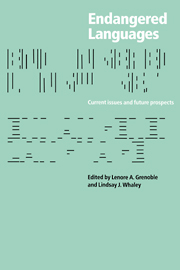Book contents
- Frontmatter
- Contents
- Preface
- List of abbreviations and symbols
- Part I General issues
- Part II Language-community responses
- Part III What is lost: language diversity
- 7 The significance of diversity in language endangerment and preservation
- 8 On endangered languages and the importance of linguistic diversity
- 9 Living words and cartoon translations: Longhouse “texts” and the limitations of English
- 10 Documenting rhetorical, aesthetic, and expressive loss in language shift
- Part IV Mechanisms of language loss
- Appendix
- References
- Index of languages
- Index of names
- General index
8 - On endangered languages and the importance of linguistic diversity
Published online by Cambridge University Press: 05 June 2012
- Frontmatter
- Contents
- Preface
- List of abbreviations and symbols
- Part I General issues
- Part II Language-community responses
- Part III What is lost: language diversity
- 7 The significance of diversity in language endangerment and preservation
- 8 On endangered languages and the importance of linguistic diversity
- 9 Living words and cartoon translations: Longhouse “texts” and the limitations of English
- 10 Documenting rhetorical, aesthetic, and expressive loss in language shift
- Part IV Mechanisms of language loss
- Appendix
- References
- Index of languages
- Index of names
- General index
Summary
Introduction
During the coming century, according to some informed estimates, 3,000 of the existing 6,000 languages will perish and another 2,400 will come near to extinction. This leaves just 600 languages in the “safe” category, assuming that category to be languages having 100,000 speakers or more. Thus, 90 percent of the world's languages are imperiled (cf. Krauss, in Hale et al. 1992). Languages in this situation are typically “local” languages, as opposed to national or international languages, and in the minds of many people, both linguists and non-linguists, their endangerment and progressive extinction amount to a catastrophe for human intellectual and cultural diversity, a disaster comparable in its extent to losses in other aspects of our environment.
The loss of linguistic diversity is a loss to scholarship and science. The scientific study of the mind is a venerable pursuit in human intellectual history, and the human capacity for language is the human mind's most prominent feature. While a major goal of linguistic science is to define universal grammar, i.e. to determine what is constant and invariant in the grammars of all natural languages, attainment of that goal is severely hampered, some would say impossible, in the absence of linguistic diversity. If English were the only language on the face of the earth, we could not know literally hundreds of things which are permitted, even predicted, by universal grammar and accidentally missing in English, or any other single language.
- Type
- Chapter
- Information
- Endangered LanguagesLanguage Loss and Community Response, pp. 192 - 216Publisher: Cambridge University PressPrint publication year: 1998
- 32
- Cited by

